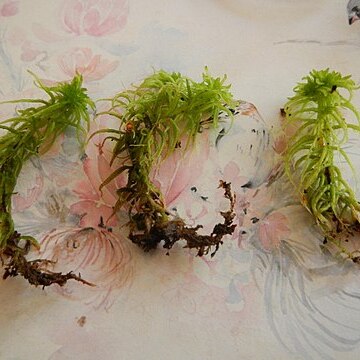Plants long, slender, pale green; terricolous. Stems 80-120 mm long; internal cylinder green to brownish green, hyalodermis efibrillose, pores few; in section inner cells of internal cylinder thin-walled, becoming smaller and thickened toward margin, hyalodermis fragile, 2 cells thick. Fascicles of 4-5 dimorphic branches: 2-3 spreading, 1-2 pendent; internal cylinder greenish, hyalodermis efibrillose, pores present on most cells. Stem leaves spathulate, 1.0-1.4 mm long; apex entensive-ly resorbed, rounded, lacerate; margins plane, border weak, 2-3 rows of narrow cells restricted to base; lower portion of leaf with obvious region of narrow cells on either side of the midline; leucocysts efibrillose, pores absent, dorsal and ventral surfaces extensively resorbed in upper portion of leaf, frequently leaving only a network of chlorocysts. Branch leaves ovate-acuminate, 1.0-1.8 mm long; apex acute, with 1-2 teeth; margins incurved above, border of 2-3 rows of narrow cells reaching upper leaf; leucocysts regularly fibrillose, pores numerous along commissures; in section chlorocysts trapezoid with wider exposure on ventral surface. Perichaetia lateral; leaves broad, spathulate, concave, apex truncate, lacerate. Pseudopodia 5-10 mm long; capsules short-cylindrical, 2 mm long, red-brown; operculum convex; spores 20-25 pm, with distinct tetrad scar, smooth.
More
Plants typically small and slender, larger and compact in the Arctic, capitulum small to moderate-sized, often with a conspicuous terminal bud; green, yellowish brown to brown; without metallic lustre when dry. Stems pale green to straw-colored; superficial cortical with a large round pore in distal portion of cell free from cell wall. Stem leaves spatulate to broad-spatulate, 0.8-1.5(-2) mm, strongly lacerate across the broad apex and often part way down the margins, border scarcely to strongly broadened at base (0.25 width of base or less); hyaline cells rhomboid, efibrillose and often 1-2-septate. Branches not 5-ranked, quite terete, long, and slender Branch fascicles with 1-2 spreading and 1-2 pendent branches. Branch leaves ovate to ovate-lanceolate; 1.1-1.5(-2) mm, slightly concave, straight; apex involute; margins entire; hyaline cells on convex surface with numerous pores along the commissures grading from small pores near leaf apex to large pores at base, concave surface with large round pores at leaf apex and along margins. Sexual condition often monoicous. Spores 20-27 µm, finely papillose on both surfaces; proximal laesura less than 0.5 spore radius.

